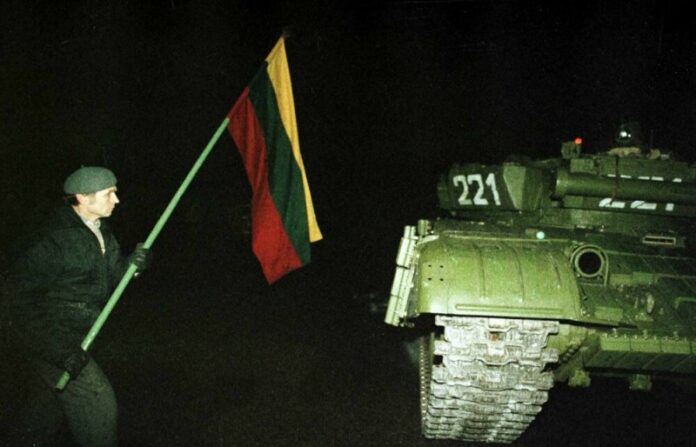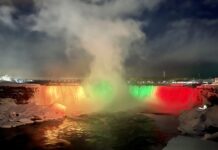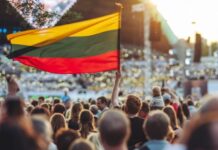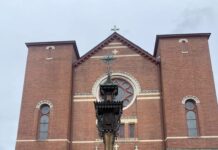
The beginning of every year marks a slough of political celebratory anniversaries for the country of Lithuania. There’s at least one celebration each month, for the first three months of the calendar year. But if you’re like me, it can become difficult to remember exactly which date represents each political victory. On which day did Lithuania gain it’s independence? How many times did it have to defend it’s freedoms? When was the standoff at the TV tower in Vilnius?
Luckily, I did some research to finally set my dates right: A guide, if you will, to Lithuania’s major modern-day political anniversaries.
Now, when my grandmother calls, at least we’ll both be on the same page and I’ll know exactly which political victory to discuss.
-
February 16th, 1918: Act of Independence of Lithuania/Vasario 16ta: Lietuvos Valstybės atkūrimo aktas

The Act of Independence of Lithuania or Act of February 16 was signed by the Council of Lithuania on February 16, 1918, proclaiming the restoration of an independent State of Lithuania, governed by democratic principles, with Vilnius as its capital.
Under King Mindaugas, Lithuania had emerged as a state in the 13th century and by the 18th century Lithuania had become part of the Russian Empire. During the first world war, the country was occupied by German troops as they advanced towards Russia.
With the Russian revolution in 1917, Germany encouraged Lithuanians to determine their future, in the hope they would prefer a union with Germany rather than Russia. They supported the establishment of a Council of Lithuania who would decide on Lithuania’s future.
Against the wishes of Germany, the Council of Lithuania decided not to align their natiion with either Germany or Russia and instead signed the Act of Independence of Lithuania on 16 February 1918. The act proclaimed the restoration of an independent and democratic State of Lithuania, with Vilnius as its capital.
Not surprisingly the publication of the Act was prohibited by the German authorities. It was only when Germany was defeated in November 1918, that the first Cabinet of Lithuania was formed and the council gained control of Lithuania.
The laconic Act is the legal basis for the existence of modern Lithuania, both during the interwar period and since 1990. The Act formulated the basic constitutional principles that were and still are followed by all Constitutions of Lithuania. The Act itself was a key element in the foundation of Lithuania’s re-establishment of independence in 1990. Lithuania, breaking away from the Soviet Union, stressed that it was simply re-establishing the independent state that existed between the world wars and that the Act never lost its legal power.
-
August 23rd, 1989 – The Baltic Way/Rugpjūčio 23čia: Baltijos Takas
On 23 August 1989, Lithuanian’s joined their hands to form a human chain stretching 650 kilometres across Vilnius, Riga and Tallinn to mark the 50th anniversary of Molotov-Ribbentrop Pact as a result of which Lithuania lost its independence. The Baltic Way was a symbolic action that separated the Baltic States from the Soviet Union and by which the Lithuanian people expressed their will to be free. They did not have to wait long. On 11 March 1990, the independent State of Lithuania was re-established.
-
March 11, 1990: Act of the Reestablishment of the State of Lithuania/Kovo 11ta: Aktas dėl Lietuvos nepriklausomos valstybės atstatymo
On March 11, 1990, Lithuania became the first republic to declare independence after Soviet occupation. The Act of the Re-Establishment of the State of Lithuania or Act of March 11 was an independence declaration by the Lithuanian Soviet Socialist Republic adopted on March 11, 1990. The act emphasized restoration and legal continuity of the interwar-period Lithuania, which was occupied by the USSR and lost independence in June 1940. It was the first time that a Union Republic declared independence from the dissolving Soviet Union.
Parliamentary elections of February 1990 were the first free and democratic elections in Lithuania since World War II. The people overwhelmingly voted for the candidates endorsed by Sąjūdis, even though the movement did not run as a political party. The result was the first post-war non-communist government. During its first assembly on March 11, 1990, the Supreme Soviet of the Lithuanian SSR elected Vytautas Landsbergis as its chairman, changed its name to the Supreme Council of the Republic of Lithuania, and formally declared the re-establishment of the State of Lithuania. The act was approved at 10:44 pm by 124 members of the council while six abstained. There were no votes against.
-
January 13th, 1991: Lithuania’s Freedom Fighter’s Day/ Sausio 13ta: Lietuvos laisvės gynėjų diena
On 13 January 1991, the Soviet Union used force to overthrow Lithuania’s legitimate government which declared the country’s independence on 11 March 1990.
After an economic blockade proved unsuccessful in curbing the Lithuanian drive to independence, Soviet troops seized key buildings throughout Vilnius in the early hours of January 13, 1991, including the TV tower. Rather than dispersing, Lithuanians from across the country poured into the capital city, ready to defend the country’s fragile independence. Faced with peaceful but determined resistance, the Soviet troops were defeated. A total of thirteen Lithuania’s were killed that day by the Soviets, and another 1,000 unarmed civilians were inured.
Although the Soviet troops managed to seize control of the TV Tower and the building of the Radio and Television of Lithuania, they did not dare to attack thousands of people guarding the Seimas.
The Lithuanians’ success in defending their independence on January 13, 1991, proved an important further step in the democratization of Central and Eastern Europe.

All images courtesy of wikipedia.org





























